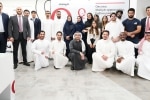
GCC countries are engaged in a construction boom that makes conventional approaches unsustainable. The problem with standard construction techniques is that they introduce waste and consume finite resources. Instead, GCC countries should apply the circular economy concept to make construction more efficient, restrain its environmental impact, and create sustainable growth.
According to the most recent forecasts, GCC capital projects could be worth more than a cumulative trillion dollars over the next five years. The construction pipeline in Saudi Arabia is promising, with many mega-projects underway such as NEOM (a city in the northwest of Saudi Arabia), the Red Sea Project (geared to tourism), and Al Qiddiyah Entertainment City.
“Using the circular economy in construction, and the built environment generally, could generate benefits of over $23bn in the GCC countries between 2020 and 2030 – equivalent to around 0.8% of the GCC region's GDP during those years.”
However, if GCC governments do not change their conventional construction approaches, they will have to use vast amounts of land, materials, and labor inefficiently. Already, conventional construction accounts for 35%-40% of the total solid waste produced by the sector, with much of this ending up in landfills.
To implement these construction plans more efficiently and with less negative environmental impact, GCC countries should use circular economy approaches. These create closed-loop material cycles across the production and consumption value chains, and treat waste as an avoidable leakage of value. Indeed, using the circular economy in construction, and the built environment generally, could generate benefits of over $23 billion in the GCC countries between 2020 and 2030—equivalent to around 0.8% of GCC-region GDP during those years.
In the GCC construction sector, introducing the circular economy means acting at each stage of the process: planning, design, and construction.
Urban planners in GCC countries should create attractive spaces where people would live, work, and play in close proximity. This would reduce the need for private transport and encourage the use of more convenient public transport. Sharing and multi-purposing of spaces maximizes their utilization and reduces the need for new buildings. Planning is also essential as it can extend the lifespan of buildings through reuse and repurposing. Urban planners can also mandate the use of district cooling in areas where it is appropriate. District cooling works by aggregating cooling demand. One centralized facility sends chilled water through a network of distribution pipes to multiple buildings. District cooling uses some 20% to 30% less electricity than the most energy efficient conventional cooling technology, an important saving given that cooling consumes the largest share of energy in the GCC region.
Governments and regulators should also introduce the circular economy into design. They can achieve this by requiring that blueprints for new buildings incorporate elements that maximize energy and water efficiency. Some measures to reduce power and water consumption are environmentally-friendly and economical. For example, a high-performance building envelope reduces heating and cooling losses. GCC countries should revise their energy-efficiency regulations given new technologies, construction designs and methods. Builders can also install solar photovoltaic panels to provide renewable electricity generation.
Finally, developers should use sustainable construction methods. For example, governments and regulators can encourage the use of modular construction, which involves building components in a factory rather than on site. Modular construction can lead to savings of up to 74% of material, 68% of equipment costs, and make construction faster and less labor intensive. Another advantage of modular construction is that it adapts more easily as space needs change. For example, the London Borough of Lewisham placed a modular 24 home structure, which can be disassembled and moved, on brownfield site. The application of 3D printing in construction can also lead to efficiency gains as it uses a fraction of the typical associated costs and construction material of conventional approaches.
“District cooling uses some 20% to 30% less electricity than the most energy efficient conventional cooling technology, an important saving given that cooling consumes the largest share of energy in the GCC region.”
Already, Dubai has launched a dedicated 3D printing strategy. However, reaping the full benefits of the transition will require a coordinated effort where all the elements of a circular built environment can come together.
One way to move toward a closed-loop of material is to create a marketplace to exchange and reuse recovered materials after disassembly. To enable such a marketplace, regulators and industry will need to introduce a “material passport” to ensure that reclaimed materials are of the appropriate quality. The U.K. already has Environmate, where builders connect to buy and sell leftover building materials. Governments and regulators can further encourage materials reuse by changing building codes. Amsterdam insists on the coordination of construction and demolition to enable the secondary use of materials.
GCC countries’ construction programs are ambitious. They will need to use the circular economy approaches to ensure that these new buildings last, are more efficient than previous construction, and have the smallest possible impact on the environment.
This article originally appeared in the July 2019 issue of Construction Week.
About the authors
Marwan Bejjani is a partner, Zahi Awad, a manager, with Strategy& Middle East, part of the PwC network and Jana Batal, senior fellow with the Ideation Center, Strategy& think tank in the Middle East.


















Menu